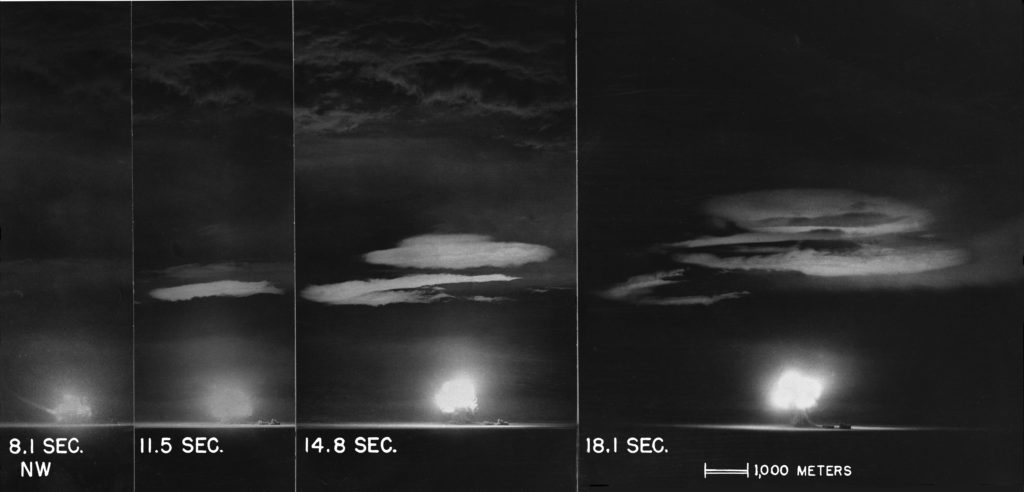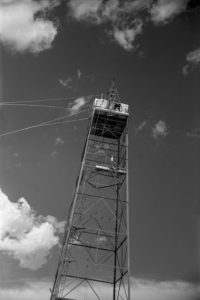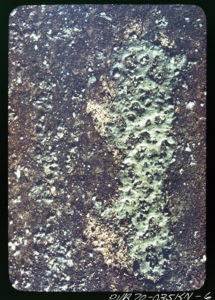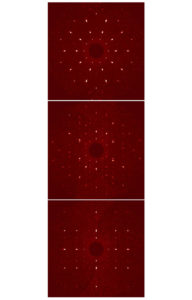Trinity Test Quasicrystal and Lightning Quasicrystal
Lightning strike : Electrical discharge triggers quasicrystal formation in an eolian dune
PNAS 120 (2022) e2215484119
Luca Bindi, Matthew Pasek, Chi Ma, Jinping Hu, Guangming Cheng, Nan Yao, Paul J Steinhardt
Trinity Test: Accidental synthesis of a previously unknown quasicrystal in the first atomic bomb test
PNAS 118 (2021) e2101350118
Luca Bindi, William Kolb, G. Nelson Eby, Paul D. Asimow, Terry C. Wallace, Paul J. Steinhardt
See also, Quasicrystals and the birth of the atomic age, Physics Today Feature
Luca Bindi, Paul J. Steinhardt
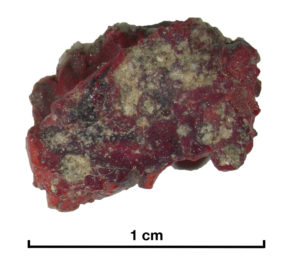
Image of the red trinitite sample including a tiny grain of quasicrystal. (L. Bindi and P. Steinhardt)
The Trinity test — the detonation of a plutonium implosion device known as the “gadget” — occurred at 05:29:45 Mountain War Time on July 16, 1945 on the Alamogordo Bombing Range, about 210 miles south of Los Alamos, New Mexico. The explosion (shown in the sequence of images above) released the equivalent of 21 kilotons of TNT (88 TJ), sufficient to vaporize the 30-meter test tower and surrounding miles of copper wires connected to recording instruments. The explosion produced a large fireball that entrained sands that rained out as fused glassy crusts and droplets that are now known as trinitite.
The paper reports the discovery in a sample of red trinitite (shown on the right) of a hitherto unknown composition of icosahedral quasicrystal, Si61Cu30Ca7Fe2 (pointed out in the electron microscope image on the left). The oxblood red color is attributed to the presence of copper oxide that formed when the copper transmission lines connected to the tower (see the left image below) were vaporized and fused with the glass. The red trinitite sample contains a complex combination of glass and metal alloys, some of which were found in the same metal droplet containing the quasicrystal, as indicated in the electron microscope image. (Note: Most trinitite is green, as shown in the middle image below taken from the edge of the crater created by the Trinity test.)
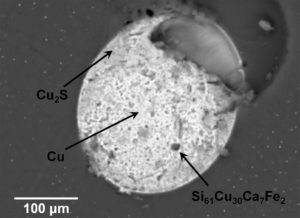
Back-scattered scanning electron microscope image of the metal droplet containing the quasicrystalline phase (the grain labeled Si61Cu30Ca7F2). (L. Bindi and P. Steinhardt)
The quasicrystal grain reported in the paper is about 10 μm across. It represents the oldest extant anthropogenic quasicrystal currently known, with the distinctive property that its precise time of creation is indelibly etched in history. This is the first evidence that the high-temperature, high-pressure conditions created by a nuclear explosion can result in the synthesis of quasicrystals.
Like the naturally formed quasicrystals found in the Khatyrka meteorite and experimental shock syntheses of quasicrystals , the anthropogenic quasicrystals in red trinitite demonstrate that transient extreme pressure-temperature conditions are suitable for the synthesis of quasicrystals and for the discovery of new quasicrystal-forming systems.
The work presented here thus motivates several new directions of research. For example, studying remnants from other nuclear test sites may yield yet other novel quasicrystalline phases and, by understanding their thermodynamic properties, provide a new tool for nuclear forensics.
aDipartimento di Scienze della Terra, Università di Firenze, Via La Pira 4, Florence, I-50121, Italy; b2702 Church Creek Ln, Edgewater, MD-21037, USA; cDepartment of Environmental Earth and Atmospheric Sciences, University of Massachusetts, Lowell, MA-01854, USA; dDivision of Geological and Planetary Sciences, California Institute of Technology, Pasadena, CA-91125, USA; eLos Alamos National Laboratory, Los Alamos, NM-87545, USA; fDepartment of Physics, Princeton University, Jadwin Hall, Princeton, NJ-08544, USA.

